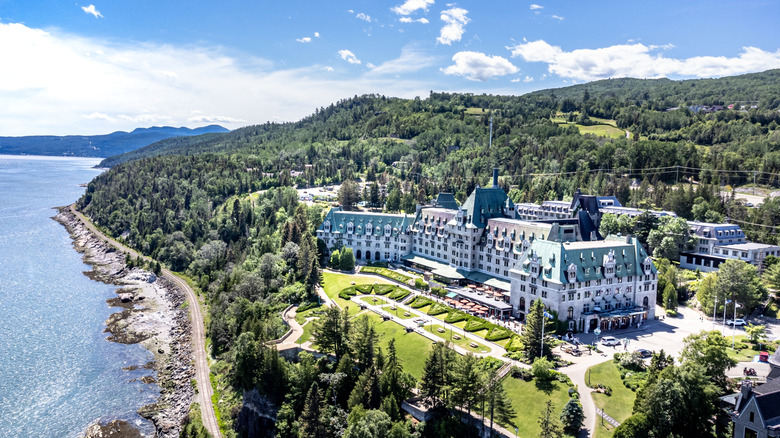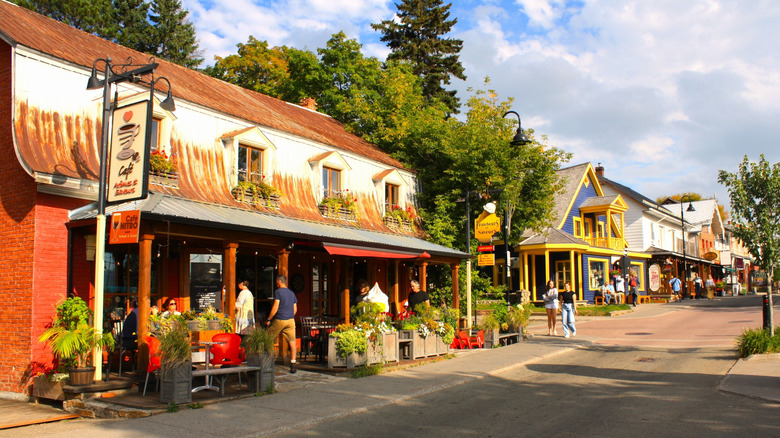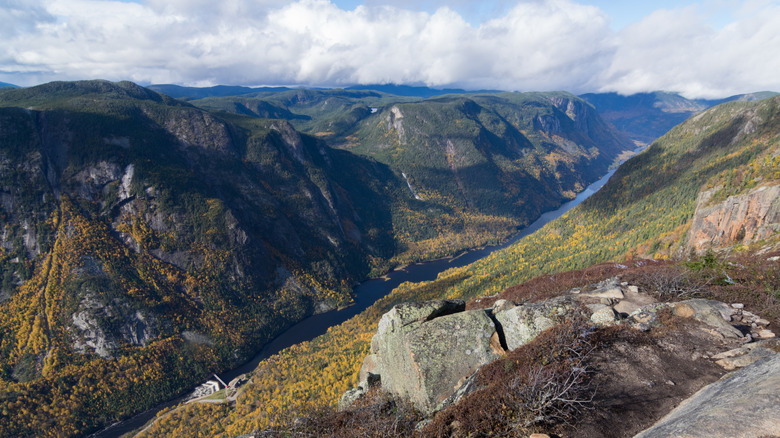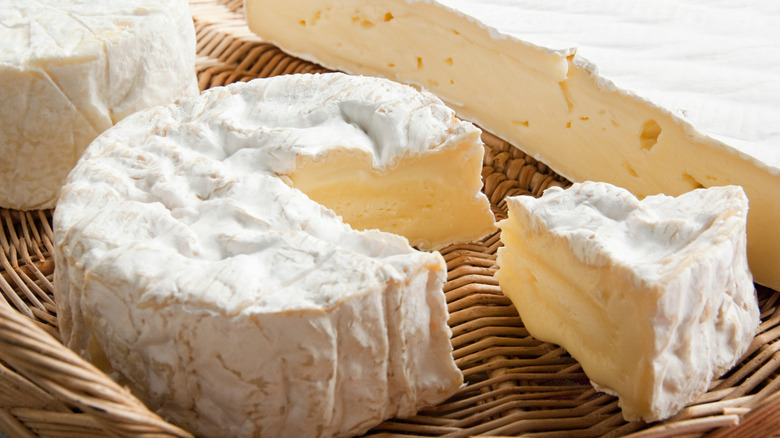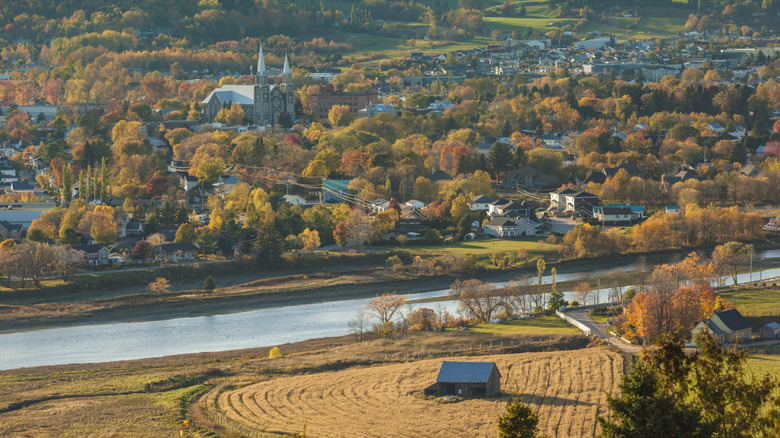A Riverside Destination In Québec Is A Secret Paradise Brimming With Art, Nature, And Gastronomy
For what it has to offer, Canada's Québec Province doesn't get nearly as much love as it should. For example, those who make it to Québec City find a European-inspired walkable gem of an urban center, but few may realize that the towns and municipalities surrounding it are great little getaways that have no business being as beautiful, lively, and culturally ahead of their time as they are. We won't say Québec is underrated, but yeah, it probably fits the bill.
Cue the stage-right entrance of Charlevoix, a regional county municipality consisting of several small storybook Canadian towns some 50 miles east of Québec City on the shores of the St. Lawrence River. Defining what makes Charlevoix special is like describing the tradition of landscape art that came to define the region in the early 20th century through the likes of Alexander Y. Jackson and Arthur Lismer — serene and dreamlike but deceptively alive all the same. The topography was formed millions of years ago when it was carved out by glaciers and pummeled by meteorites, and the result is the picturesque geography of granite domes, glacial valleys, cliffs, and rivers you see today.
All of this is accented by an abundance of pastoral farmland, where local producers create a wealth of cheese, wine, cider, and charcuterie in a North American tradition that's in no hurry to forget its European roots. It might sound reductive to say that the people living here simply like the good things in life to be, well, great, but that's exactly the region's allure — Charlevoix is a place to indulge yourself in the area's natural scenery, myriad art festivals, and rewarding gastronomic oddities. Here's how to make the best of a trip there.
Charlevoix's rich art heritage and scene
The Charlevoix region has a history of captivating artists with its natural vistas. Canada's famed Group of Seven — an informal cohort of similar-minded artists from Toronto's Arts and Letters Club from the 1920s — would go on to form a country-wide landscape painting movement in which Charlevoix often featured heavily. That heritage is woven into the region's DNA, and it shows. Visitors can stop by numerous museums and art exhibitions in the area, including the Baie Saint Paul Museum of Contemporary Art, which features year-round contemporary exhibits from artists around the globe and hosts an art symposium every summer.
Music lovers should likewise check out the Domaine Forget de Charlevoix summer music festival in Saint Irénée up the St. Lawrence River. The international festival hosts over 30 jazz, classical, and dance music concerts and more than a dozen musical brunches. The Domaine Forget de Charlevoix complex is situated on a 100-acre historical property featuring an admission-free sculpture garden, so even if you miss the festival, you can still take a rewarding cultural stroll through its grounds.
If you're looking to cover as much cultural ground as possible and get in touch with local artists on a more personal level, we highly recommend embarking on the Charlevoix Art Trade Route. This route takes you to nearly a dozen art studios and museums in the region's towns and villages, covering pretty much any and every art style, medium, and craft you can think of. You'll need a car to do it, and it's best split into a two or three-day trip, but it's a great way to see the Charlevoix area while taking in the local art scene.
The immense nature of Charlevoix
Perhaps the Charlevoix region's greatest allure is the same natural setting that inspired Canada's landscape painters in the early 20th century. And for its relatively modest size — under 2,500 square miles — the municipality packs in a surprising amount of topographic diversity. The region has been a UNESCO Biosphere Reserve since 1988 and includes everything from forests and river ecosystems to estuarine tidal marshes and mountain tundras.
Four hundred million years ago, a meteorite fell in Mont des Éboulements, leaving a 33-mile-wide crater near the town of Baie Saint Paul to La Malbaie. Half of it is under the St. Lawrence River, and the best way to view it is to hike up to Mont du Lac des Cygnes on the crater's northern summit, a three to six-hour round trip featuring excellent views of the surrounding Laurentian mountain valleys. The hike (along with many other fantastic routes) is located in the middle of the Grands Jardins National Park, a standout outdoor destination in the region. Kayak, fish, cross-country ski, or simply observe the area's unique flora and fauna, as Grands Jardins makes up the heart of the UNESCO Biosphere Reserve. To get a more comprehensive feel for the region's highland terrain, embark on the Mountain Road, a 75-mile marked path that leads hikers to some of the highest outlooks in eastern Canada. It will take you through the Grands Jardins National Park and Hautes Gorges de la Rivière Malbaie National Park, the latter of which is known for its glacier-carved, high plateau landscape and waterfall cascades.
Where to eat and drink in Charlevoix
It almost feels unfair for a single municipality in Canada to have so much going for it, and Charlevoix's gastro scene underscores that fact. Thank the region's French heritage for the fact that wine and cheese lovers will find a lot to be happy about here. Famille Migneron de Charlevoix in Baie St. Paul is a small Nordic vineyard and distillery that is well worth your time, producing artisan cheeses from cow and sheep milk. Try their whey-based Charlevoyou spirit for something different.
Laiterie Charlevoix is another dairy producer in town that has been making inventive cheeses since the 1940s, and Charcuterie Charlevoisienne in St. Urbain is a great option for visitors looking to add European-inspired charcuterie to their wine and cheese nights. An unquestionable Charlevoix standout is Omerto, a winery outside of Baie St. Paul that uses tomatoes specially adapted to the region and a generations-old family recipe to make its distinct tomato wines. For a sweeter option, Hydromel Charlevoix (a winery that produces honey wines and spirits) falls under the same perplexingly delicious category of "I haven't heard of this, and I must try it." There's almost too much to taste; the region is replete with microbreweries, distilleries, and cider houses of all kinds, and it's hard to go wrong.
Baie St. Paul also runs an annual film festival focusing on food-related cinema called Cuisine, Cinema & Confidences, where an international cadre of chefs prepare food based on curated film screenings. It's a near-perfect avatar of Charlevoix's history of and dedication to food and the arts, and you're unlikely to come away from it anything less than highly satisfied.
Where to stay in Charlevoix and how to get there
Getting to Charlevoix is pretty straightforward. The nearest major hub is Québec City Jean Lesage International Airport, about an hour's drive away. Montréal is roughly four hours away by car, but it's a pleasant journey with plenty of views to take in as you go, so consider it for a summer road trip (or in the fall when the leaves start to turn).
You won't be left wanting for accommodation choices when you arrive. If you're in the mood for a stately stay, head to Fairmont le Manoir Richelieu, a literal mansion resort overlooking the St. Lawrence River whose rooms are more affordable than you might think. Glamping is a popular option in Charlevoix, with places like Momentôm Refuges Nature offering cozy rustic getaways starting at $300 (CAD) a night. You've got everything from the standard mid-range hotel chains to more unique stays like the Villa Expérience Nature Le Nid, a three-story chalet villa in the hills above the river north of St. Irénée. Let it not be said that the region doesn't cater to decadence.
As for when to visit, Charlevoix is lovely year-round, so it really depends on what you're looking for. Summer here is all lush nature and buzzing townscapes, while winter is a quieter (and overall cheaper) snowy playground. The region sees millions of tourists every year, the bulk of which arrive in the summer, leading local tourism authorities to promote the area's offseason draws in recent years. That approach seems to have worked for Saint Gabriel de Valcartier, another small municipality not far from Québec City that is home to North America's one and only ice hotel. Small towns in Québec, it seems, are just different.
